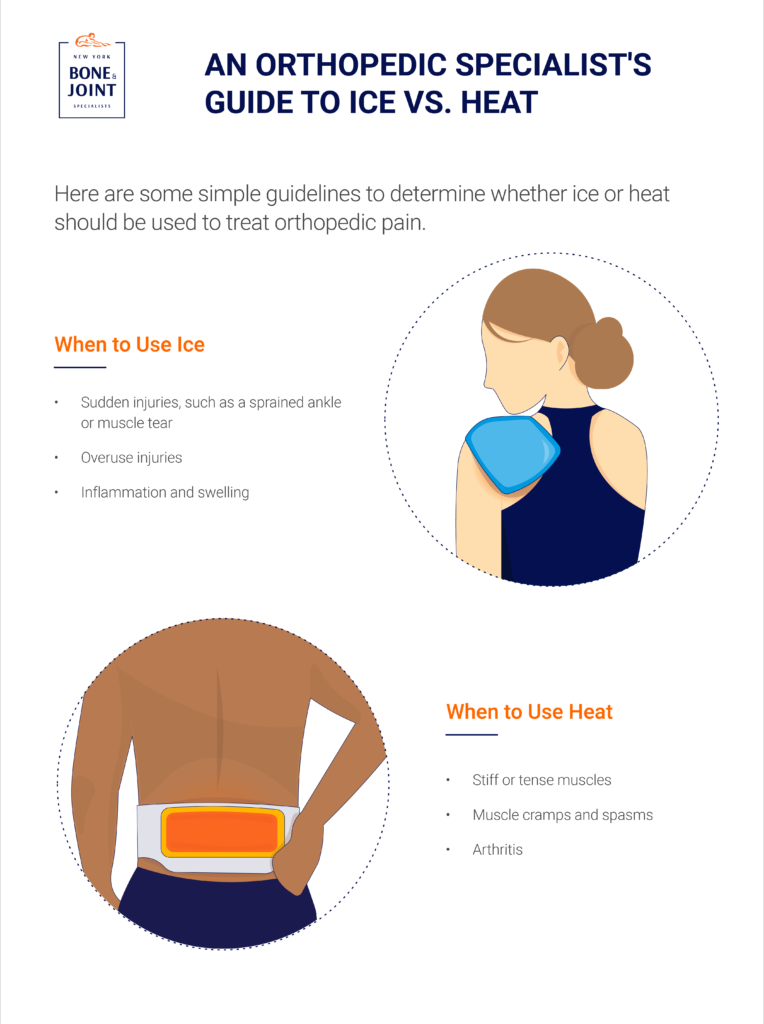Applying a cold or warm compress to an orthopedic injury can bring immediate pain relief. But how do you know when to use each therapy?
When you get hurt, your first instinct is to make the pain go away as soon as possible. Common advice is to apply either ice or heat to the area to get relief and promote healing. But which therapy is better for which type of injury?
The option you choose depends on the specific injury you’ve suffered. Fortunately, there are simple guidelines that dictate when ice and heat should be used to treat orthopedic pain.
When to Use Ice
Ice works best for sudden injuries, such as a sprained ankle or muscle tear that may occur during a sporting event or workout. Ice therapy is also good for overuse injuries, which is why you see pitchers strap an ice pack on their shoulder after a game. The goal is to quickly reduce swelling and inflammation around the injured area. Applying a cold compress immediately cuts off blood flow in order to bring down the swelling. Ice also numbs the area, so pain is minimized.
For cold therapy, you can use a pre-made ice pack, a bag filled with ice, coolant spray, or a package of frozen vegetables. In some instances, you may want to soak the painful joint in an ice bath.
However, applying ice for too long or too often can damage your skin. It’s therefore recommended that you limit the icing therapy to 10 to 15 minutes per session. You can, however, apply the ice between eight to 10 times a day.
Ice therapy is not recommended for people with poor circulation, or who have nerve damage from a condition like diabetes that makes it difficult to feel extreme temperatures.
When to Use Heat
Heat therapy is the preferred treatment for stiff muscles, muscle cramps and spasms, and arthritis. By boosting blood flow to tense muscles, heat relaxes the muscles, which increases flexibility and mobility. An open wound or significant swelling should not be treated with heat therapy.
To administer heat therapy, you have several options, ranging from heat patches and heating pads to saunas. The heat can be dry, such as with a patch, or wet, such as with a warm, moist towel. Make sure the heat is warm, not extremely hot. Target the heat to the area where you feel the most pain and stiffness. If your whole body feels stiff, a sauna or warm bath is a good option.
Minor pain and stiffness can be treated for between 15 to 20 minutes with heat therapy. If the pain is more severe, apply the heat for 30 minutes, or to up to two hours if you’re in a bath or sauna.
Heat therapy is not for everyone. People with diabetes, dermatitis, heart disease, hypertension, vascular disease, or deep vein thrombosis should avoid heat therapy.

When to Use Both
Alternating between cold and hot therapy is another option for treating acute orthopedic injuries. Wait between three to five days after the injury before beginning the hot/cold treatments. Once the cold compress has reduced the pain and swelling, you’ll want to get the blood flowing to the area again with heat. The heat allows fresh nutrient-rich blood to rush to the injured joint or muscle after it’s been “cleared out” by the cold therapy.
Start your hot/cold therapy program with an ice pack, keeping it in place for two minutes before switching to heat. Apply the heat for about two minutes as well. Repeat a cycle of cold followed by hot therapy three times, always ending with the cold treatment.
Don’t Live with Pain
At-home treatments such as hot and cold therapy are important, but they may bring only temporary relief. If the pain doesn’t diminish within three to five days, it’s time to visit New York Bone & Joint Specialists. Our doctors and physical therapists can diagnose and treat your injury so you can live an active and pain-free life. Contact us today for a consultation.




